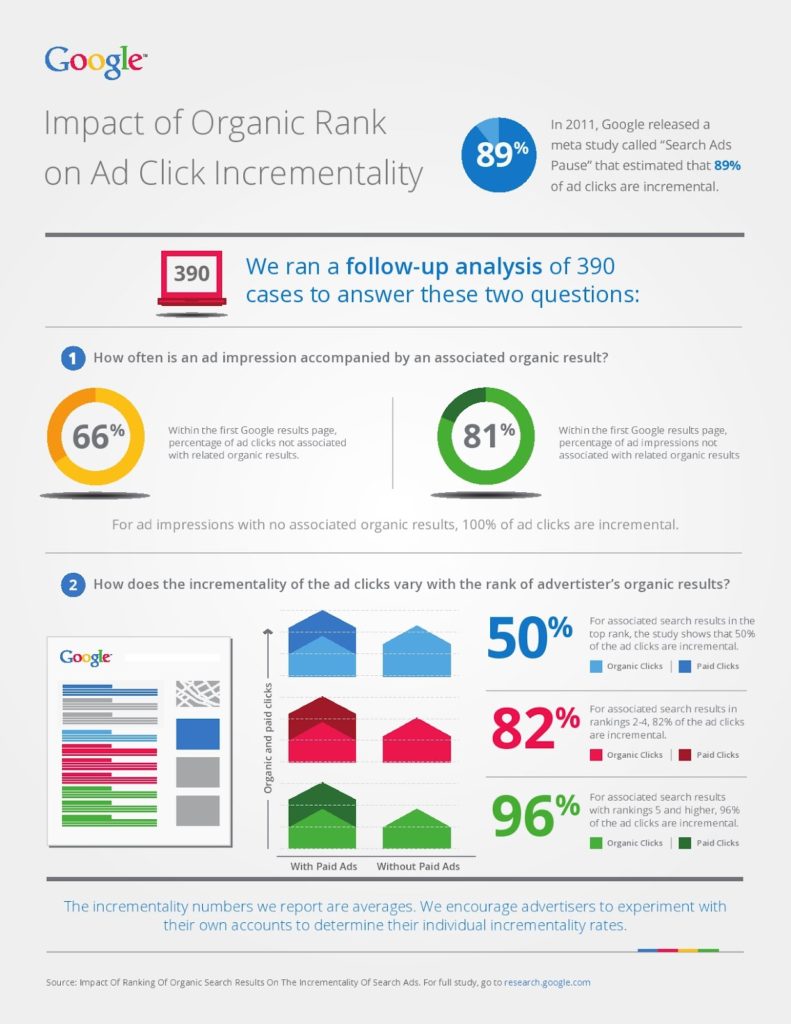The role of branded and unbranded search terms in digital enrollment marketing
It’s nearly impossible to overstate the importance of search engine marketing (SEM) in 2019. More than 5.6 billion searches are performed on Google alone every day – that’s more than 63,000 a second and more than 2 trillion a year. The people performing those searches ultimately choose a business that appears on page one of their search results 98% of the time, and the majority of those people choose a result close to the top of the first page.
While organic optimization is always important and serves as an excellent foundation for building a digital presence, you simply can’t rely on organic SEO to drive the awareness and inquiries you need.
A Google study indicated that even if your organic listing appears on the first page of results, an accompanying paid listing can provide an incremental increase of 50% more clicks. Conversely, if you were to pause your Google ads, the company has found, 89% of the traffic those search ads generated would not be replaced by organic clicks.
If you were to pause your Google ads, 89% of the traffic those search ads generated would not be replaced by organic clicks.
Fortunately, while SEM is an investment, it’s an investment with a great return. For every dollar you spend on Google AdWords, you’ll earn an average revenue of $2.00. And with 40% of brands looking to increase their PPC budgets, all indications point to digital ads continuing to be an effective, lucrative and growing tool for marketers.
Great! So, you know how important SEM is to your enrollment marketing goals. Now what?
We have a lot of clients ask us whether they should focus on branded terms (like those that include the name of their institution) or unbranded terms (like those that focus on degree titles and outcomes) when they are developing their SEM strategy and analyzing keywords. The answer is an emphatic … neither.
You simply should not choose between branded and unbranded search terms. It is imperative to incorporate both search strategies in your recruitment marketing efforts. Instead of thinking of it as an “either/or” scenario, consider the two as having completely different roles – complementary to each other as they work together throughout the prospective student’s journey. Here is how – and when – to use unbranded and branded search to help meet your enrollment goals:
Use non-branded search terms create demand for your institution (or programs).
Unbranded keywords are essential for attracting new prospective students that may not have previously been exposed to your brand. After all, your school’s name isn’t going to do much to attract someone who has never heard it before, right? What will grab their attention are goal-focused terms related to their search. Think “healthcare degree programs near me,” “online MBA program” or “art school.”
Unbranded keywords like these have significantly higher search volume than branded keywords, which means they are going to be more expensive than bidding on your brand name. Users are also typically earlier on in their search, so intent tends to be lower. Don’t let that deter you – just make sure you account for this your strategy, budget planning, and performance expectations. There are certainly relevant terms for your institution that are worth the higher price tag and ranking for them is important.
What’s more, generic program terms, such as “MBA” and “Master of Education,” tend to drive significant search traffic, but they’re also very difficult to rank for. Consider the search opportunity that remains among more niche, unbranded queries relating to concentrations and areas of focus, like “Accounting MBA Degrees” and “Curriculum and Instruction M.Ed Programs.” Then keep honing in.
Layering the more expensive (most general) unbranded keywords with additional data points and targeting such as audiences, geography and time of day is crucial to making these terms cost-effective. The more specific you can get, the less you’ll pay.
Insider tip: Traffic from unbranded terms can also be leveraged to build additional lookalike and retargeting audiences for Facebook. You can then craft unique messaging and value propositions for these audiences and increase the likelihood of engagement.
Use branded search to capture demand for your institution (or programs).
Branded keywords are essential when it comes to capturing and converting prospective students who are already considering your institution and just need to take the final steps. The prospects who are interested in your school by name are likely further along in the journey and closer to taking action. This means that although branded search terms will be less expensive to bid on than unbranded search terms, they typically result in much higher-value leads.
Leverage your paid search budget this way to maximize conversion of already interested prospective students seeking out your brand. Without incorporating these branded ads, all your work to optimize for unbranded search terms will potentially be wasted. You already spent significant money to generate interest in your offerings, most likely, now it’s time to convert that interest. If you aren’t investing in the lower-funnel search activity that comes just before a prospect takes action, you’re potentially throwing away money you already spent to gain their interest.
Understand, too, that maintaining a strong paid search presence is both an offensive and a defensive strategy. If you aren’t actively bidding on your brand in search, it is very possible that your competitors will poach these queries.
Insider tip: Closely monitor your business reviews and location listings in Google. If reviews are largely positive, consider incorporating them into paid search ads via seller rating ad extensions as a way to back your branded listings with “proof.”
Curious about the ratio of unbranded to branded search terms you should aim for? Unfortunately, there is no one-size-fits-all approach. There are certainly best practices you should follow (and this is one of them), but there is no official formula for how you should incorporate branded and unbranded search terms. Every institution is different, and their SEM strategies should be as well. Consider factors like market share, competition, program demand, as well as the age and health of your programs and enrollment goals as part of your keyword strategy.
Do you need more support when it comes to search engine marketing? You’re in the right place. Archer’s ROI-obsessed, partnership-first approach to digital marketing means we turn your marketing dollars into high-interest prospective students, at scale. Contact us to learn how to get started!




